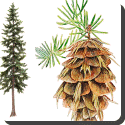 Douglas Fir — Douglas-fir is the common name applied to coniferous trees of the genus Pseudotsuga in the family Pinaceae. There are five species, two in western North America, one in Mexico and two in eastern Asia. The Douglas-firs gave 19th century botanists problems due to their similarity to various other conifers better known at the time; they have at times been classified in Pinus, Picea, Abies, Tsuga, and even Sequoia. Because of the distinctive cones, Douglas-firs were finally placed in the new genus Pseudotsuga (meaning “false Tsuga”) by the French botanist Carrière in 1867.
Douglas Fir — Douglas-fir is the common name applied to coniferous trees of the genus Pseudotsuga in the family Pinaceae. There are five species, two in western North America, one in Mexico and two in eastern Asia. The Douglas-firs gave 19th century botanists problems due to their similarity to various other conifers better known at the time; they have at times been classified in Pinus, Picea, Abies, Tsuga, and even Sequoia. Because of the distinctive cones, Douglas-firs were finally placed in the new genus Pseudotsuga (meaning “false Tsuga”) by the French botanist Carrière in 1867.
The common name honours David Douglas, the Scottish botanist who first introduced the tree into cultivation in 1826. Douglas is known for introducing many North American native conifers to Europe. The hyphen in the common name indicates that Douglas-firs are not true firs; i.e. they are not members of the genus Abies.
The Douglas-firs are medium-size to large or very large evergreen trees, to 20-100 m tall. The leaves are flat and needle-like, generally resembling those of the firs. The female cones are pendulous, with persistent scales (unlike true firs), and are distinct in having a long tridentine (three-pointed) bract that protrudes prominently above each scale.
Douglas-firs are used as food plants by the larvae of some Lepidoptera species including Autumnal Moth, Bordered White, The Engrailed, Pine Beauty, Turnip Moth and the gelechiids Chionodes abella and Chionodes periculella which have both been recorded on P. menziesii.
A Californian Native American myth explains that each of the three-ended bracts are a tail and two tiny legs of the mice who hid inside the scales of the tree’s cones, which was kind enough to be the enduring sanctuary for them during forest fires.
Douglas-fir can attain heights of 120 metres (394 ft). That was the height of the tallest tree (of any species) ever well-documented, the Mineral Tree (Mineral, Washington), measured several times between 1911 and 1925 by Richard McCardle, a University of Washington forester. The volume of that tree was 515 cubic meters (18,190 cu ft). The tallest extant individual is the Brummitt Fir (Coos Bay, Oregon) at 100.3 meters (329 ft). Only Coast Redwood grow taller.
Douglas-fir wood is used for structural applications that are required to withstand high loads. It is used extensively in the construction industry. Other examples include its use for homebuilt aircraft. Very often, these aircraft were designed to utilize Sitka Spruce, which is becoming increasingly difficult to source in aviation quality grades. Douglas-fir are also the most common Christmas trees in the United States where they are sold alongside true firs like Noble and Grand. Douglas-fir Christmas trees are usually trimmed to a near perfect cone instead of left to grow natural like Noble and Grand.
 Kids Portal For Parents India Kids Network
Kids Portal For Parents India Kids Network






